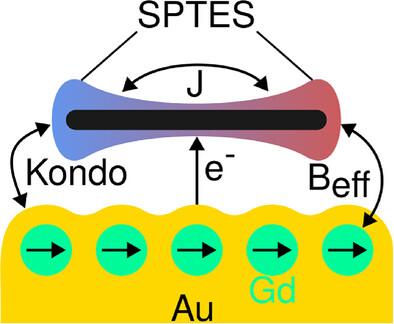二维铁磁上手性石墨烯纳米带拓扑末端态的自旋和电荷控制
IF 26.8
1区 材料科学
Q1 CHEMISTRY, MULTIDISCIPLINARY
引用次数: 0
摘要
定制的石墨烯纳米结构可以表现出对称保护的拓扑边界态,在半填充时具有局域自旋1/2磁矩。然而,人们经常观察到在铸币金属衬底上的电荷转移,这导致了封闭壳结构。本文利用低温扫描隧道光谱技术,证明了直接在铁磁体GdAu2上合成的原始拓扑非平凡手性石墨烯纳米带既可以保持电荷中性的双自由基状态,也可以转化为单阴离子双重态。通过开尔文探针力显微镜和自旋翻转光谱学的验证,确定了由莫尔海姆诱发的上层结构调制的功函数和交换场。联合静电和磁相互作用允许通过原子操纵在三个自旋多重度之间可逆切换。介绍了一种有效的Hubbard二聚体模型,该模型结合了局部静电门控、电子-电子相关、杂化和交换场的影响,勾勒出了可达自旋态的相图。这些结果为金属基体上π自由基的局部控制奠定了基础。本文章由计算机程序翻译,如有差异,请以英文原文为准。

Spin and Charge Control of Topological End States in Chiral Graphene Nanoribbons on a 2D Ferromagnet
Tailor-made graphene nanostructures can exhibit symmetry-protected topological boundary states that host localized spin-1/2 magnetic moments at half filling. However, one frequently observes charge transfer on coinage metal substrates, which results in closed-shell configurations. Using low-temperature scanning tunneling spectroscopy, it is demonstrated here that pristine topologically nontrivial chiral graphene nanoribbons synthesized directly on the ferromagnet GdAu2 can either maintain a charge-neutral diradical state, or convert to a singly anionic doublet. As an underlying mechanism, both a work function and an exchange field modulated by the moiré-induced superstructure are identified, as corroborated by Kelvin probe force microscopy and spin-flip spectroscopy. The joint electrostatic and magnetic interactions allow reversibly switching between the three spin multiplicities by atomic manipulation. An effective Hubbard dimer model is introduced that unifies the effects of local electrostatic gating, electron–electron correlation, hybridization and an exchange field to outline the phase diagram of accessible spin states. These results establish a platform for the local control of π-radicals adsorbed on metallic substrates.
求助全文
通过发布文献求助,成功后即可免费获取论文全文。
去求助
来源期刊

Advanced Materials
工程技术-材料科学:综合
CiteScore
43.00
自引率
4.10%
发文量
2182
审稿时长
2 months
期刊介绍:
Advanced Materials, one of the world's most prestigious journals and the foundation of the Advanced portfolio, is the home of choice for best-in-class materials science for more than 30 years. Following this fast-growing and interdisciplinary field, we are considering and publishing the most important discoveries on any and all materials from materials scientists, chemists, physicists, engineers as well as health and life scientists and bringing you the latest results and trends in modern materials-related research every week.
 求助内容:
求助内容: 应助结果提醒方式:
应助结果提醒方式:


